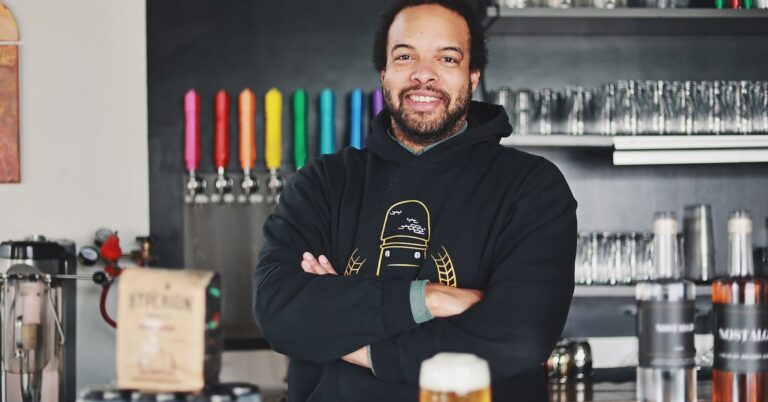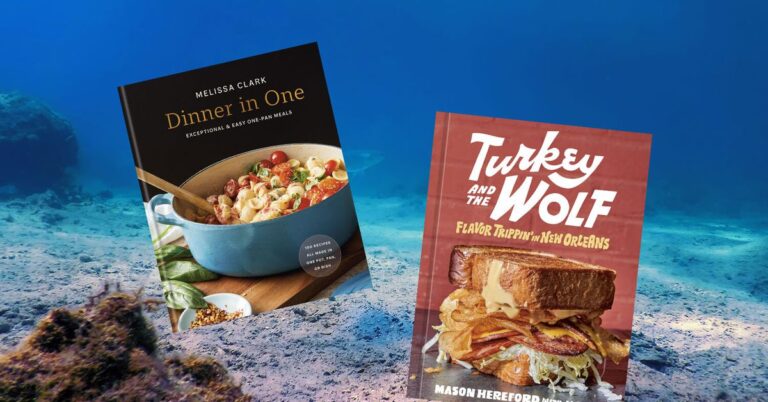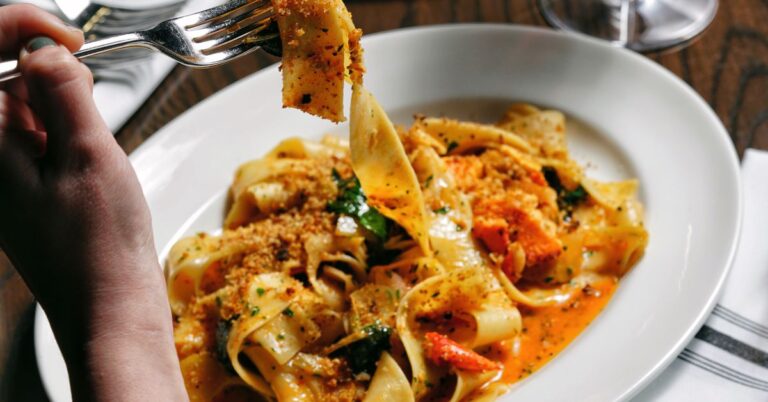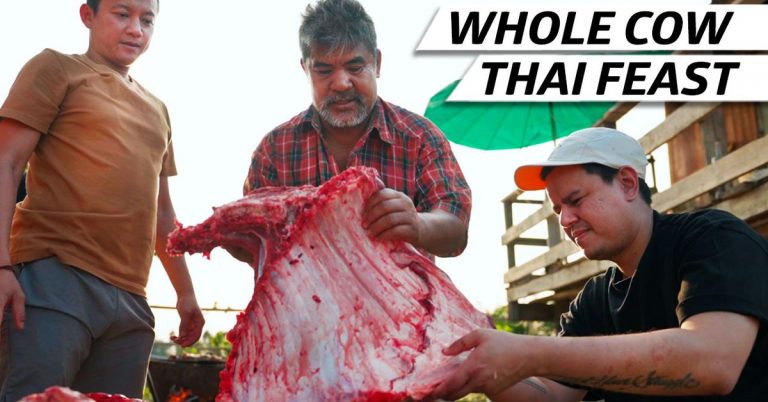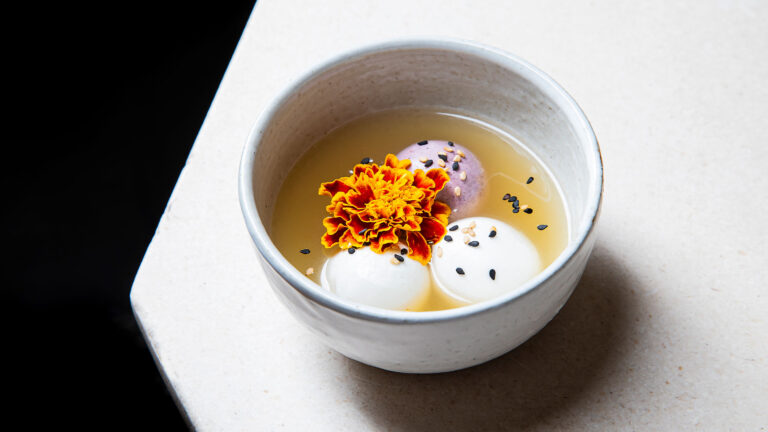What Makes a Bar Queer? Explores Friends and Family in Oakland
On a Thursday night at the start of fall, the hum at Friends and Family, located on 25th Street off Telegraph in Oakland, builds gradually. At first, the small open space resounds with the movements of bartenders pairing vodka, rose, lime, and Peychaud’s in drinks with names like “Mom’s Rosy Cheeks,” while other members of the team scoot chairs and place table settings. As the sun disappears more customers shuffle down the pink hallway in search of a cocktail and grilled cheese sandwich. If they’re lucky, or early, they’ll get seated right away — but those arriving later than 8 p.m. often have to wait to dine under Friends and Family’s soft lighting, drink from glasses made to look antique, or watch diners sitting at the bar, their faces reflected in a backlit five-foot semicircle mirror that gives the impression of a sun setting over downtown Oakland.
It’s not just the soft-femme decor that sets the Friends and Family space apart from others you might find in the East Bay: The bar brags that it’s a woman- and queer-owned space, and you can feel it. Queer-looking and well-dressed (think razor-cut shag hairstyles, clogs, straight-cut jeans or Dickies) femme people (as beautifully written by Kesiena Boom, femme is “a term that comes from working-class lesbian culture” and a “further explanation of one’s gendered existence in the world”) dominate the front-of-house staff. And it’s not just those who run the show either: Femme and woman-presenting customers outnumber masculine-of-center people 10 to one. Everyone looks gay.
:no_upscale()/cdn.vox-cdn.com/uploads/chorus_asset/file/22964612/LindseyShea_2.jpg)
If you were to Google “queer bars in the East Bay,” however, Friends and Family wouldn’t come up. That’s because, as owner Blake Cole says, the bar and restaurant isn’t a queer bar and restaurant; rather, it’s a space that’s for everyone by queer people. “We are first and foremost a bar and a restaurant and a place for everybody to come to. But also, something that’s been amazing is the way that the queer community has really shown up and adopted this space. I really don’t think that there is a lot of places that aren’t exclusively dive bars that people in the queer community can go out to and still feel safe,” Cole says.
And Cole is right. The last decade in the Bay Area has seen a smattering of closings and openings, but the pace of the latter can’t seem to outcompete the former, even as the number of queer- and trans-identifying people grows. Bars in San Francisco, where rent prices arguably spiked first and worst in the Bay Area, dropped like flies: Marlena’s, Esta Noche, and the Lexington Club all closed within two years of each other in the mid-2010s. At the time, Lila Thirkield, owner of lesbian bar the Lex, wrote in a Facebook post, “When a business caters to about 5% of the population, it has tremendous impact when 1% of them leave. When 3% or 4% of them can no longer afford to live in the neighborhood, or the City, it makes the business model unsustainable.” Across the country, lesbian bars seem to suffer the worst fates of gay spaces, going from 200 bars in 1980 to 21 in 2021. It’s not all bad: One of the city’s oldest haunts, Wild Side West, is still here after six decades of service, and in the East Bay, the White Horse Inn, which claims to be one of the country’s oldest continuous-running queer bars, is still going strong.
But a new generation of spaces in the East Bay is creating and defining queer culture — and queer bars — anew. There’s the Port Bar, which opened in late 2016, situated a couple of doors down from the historic Paramount Theatre on Broadway in Oakland. Friends and Family had its first day of service on April 25, 2020. Just a couple of blocks away lives Qué Rico, a queer nightclub and restaurant that opened in April 2021.
Bars have long created and sustained queer communities; sites where queer people could express themselves as queer people, offering an escape from an outside world that vilified queerness and gender difference. Now, we’re offered, however nascent, federal protections, like access to marriage and subsequent marital rights. But attempts to bring queer and trans folks into the folds of legal American life do not make for a full cultural revolution, nor can they undo the impacts of historical violences, like the Lavender Scare, a postwar moral panic against homosexuality fomented by the federal government, or the implicit messages of the government’s refusal to mitigate the HIV/AIDS crisis and invest in the health of Black and brown queer and trans people. For decades, laws against cross-dressing and sodomy filled the pages of municipal rule books. Government praxis cemented a public imaginary of anti-queer and trans belief in one’s filth and unworthiness. Hiding in plain sight, through efforts to “pass” as cis or straight, was a makeshift shield against the outside world’s homophobia and transphobia.
Bars could be a solace from all of that.
Perhaps most importantly, queer bars were — and remain — places where queer and trans people can meet peers, flirt, and potentially find someone to take home. When so many of the trappings of social and cultural life have been withheld to prevent queer and trans people from loving and building families, queer bars are a rebellion against all of that, says Ry, a bartender at the Port Bar and Friends and Family who declined to give her last name for privacy reasons.
Queer bars are reminders that it’s possible to fall in love, make friends, and build families other than the ones offered at birth. Put simply, queer bars facilitate queer love: love of queer self, love of queer community, and love of other queer people. That remains true for Cole, who met her partner through the process of building out Friends and Family, which she calls a “love letter” to her own queerness. Ry also met her partner at the Port Bar standing in line for the bathroom.
The Port Bar, named for the Port of Oakland, is shaped like a shipping container and many of the physical elements of the space, like the bathroom, are built using repurposed shipping containers. The space — with its high ceilings and six largescale paintings of important queer and trans movement leaders like Audre Lorde and Silvia Rivera — is intentionally Oakland, featuring wood from Oakland’s former Army barracks and corrugated steel from the former Capwell Emporium building.
The Port Bar advertises itself as a queer space, but straight people also come to enjoy drag brunch or trivia night. In one sense, Ry says, “We’re just, as bartenders, pouring out drinks, but you really are providing this safe space and a comfort that a lot of us didn’t get at home. I think that comes with a really big responsibility.” Ry is referring to a responsibility of setting the bar’s tone; if straight bars are an extension of the straight world, where queer and trans violence is often tolerated or sometimes even encouraged, queer bars are a bulwark against that world. “It’s still like, either be groovy or leave,” Ry says. “You [either] love this space and love the people who occupy it and perform or leave.”
For Valentino Carrillo, owner and operator of Qué Rico, his space also serves a need for the queer community. “We primarily cater to more of the Latino community or the Latinx community here, but our crowd, I want to say, is probably one of the most diverse,” Carrillo says. Before Carrillo opened Qué Rico, he says Latinos primarily went to the now-shuttered Club 21, formerly known as Club Bench and Bar, where he was the operations and marketing director. “When that went away, basically there was this big void.”
:no_upscale()/cdn.vox-cdn.com/uploads/chorus_asset/file/22964772/Valentino_Carrillo.jpeg)
As the needs of queer communities shift, Carrillo reflects on how expressions of queerness have also changed. As a young adult, Carrillo says that more of his peers were closeted, part of that self-protection required embodying a kind of stereotypical masculinity. Now, Carrillo says, “There are a lot more guys that are much more feminine. And they’re open about, you know, their sexuality and what they like.” Carrillo says that it’s different now, to see younger people, even teens, coming out earlier “because [queerness] is more accepted in society, so they’re more free-spirited.” He says that Qué Rico is a queer space for those at the beginning of their identity exploration and for people like Carrillo, who have been out for years.
Cole compares her approach to creating queer space to that of Tanya Saunders, the longtime owner of Cubbyhole, a lesbian bar in Manhattan. “Tanya wanted a bar that would be open to everyone,” Cubbyhole’s current owner Lisa Menichino said in a documentary short produced by filmmakers Elina Street and Erica Rose, co-creators of The Lesbian Bar Project. “She wanted it to be a lesbian bar where straight people would feel welcome, trans people would feel welcome, where neighborhood people would feel welcome and that’s what she created,” Menichino continues. Menichino’s words resonated with Cole. “I was like, I think that’s really cool. And that’s kind of how I see my bar,” she says.
“My queerness and also my identity as a woman inform all the decisions that I make in my life, and inform so much of who I am. So of course, it would inform the business that I create,” Cole says. “I think my queerness and the queerness of the majority of people on the staff is what adds to the magic of the space, because I inherently believe those things about us make us better people.”

